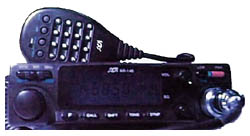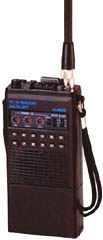Ham Radio Operator
Insider Info
In the days before the Internet and cheap long-distance telephone packages,
it wasn't easy talking to your friends around the world. This is what made
ham radios so popular. Even though worldwide communication is easier these
days, ham radios are still popular.
Ham radio is a nickname for amateur radio, a service and hobby for people
who like to communicate over long distances using radio technology. With two-way
radio equipment, ham radio operators can talk from anywhere, be it from their
homes, cars, boats or even the great outdoors.
 |
| This is a mobile ham radio. These radios can be used for worldwide
communications or for chatting with friends across a parking lot. There are
even gateways between ham radio and the Internet. |
| Courtesy of: Radio Picture Archive |
Where does the "ham" come from? Nobody knows for sure. One theory is that
"ham" is a mutated form of "am," which is short for amateur. Another theory
holds that it comes from the way operators sometimes "ham it up" on the air.
Amateur radio began as a hobby as soon as radio communication became possible.
The inventor of the "wireless" was Gugliemo Marconi. In 1895, he sent a long-wave
radio signal over a mile's distance. Then, in 1901, in a tower in St. John's,
Newfoundland, he received a radio-wave signal sent out from England. He heard
the clicking sound of Morse code -- it was the letter "S." Marconi conquered
the ocean with his trans-Atlantic transmission and, in doing so, astounded
the world.
In the few years that followed, people experimented like crazy with radio.
Eventually, the government stepped in to regulate things and create order.
For example, it reserved certain frequencies for specific uses, like commercial
radio and television stations.
You've probably played around with walkie-talkies before. Amateur radio
includes that and much more. Veteran "ham" Gary Pearce explains it this way:
"The international coordinating bodies have provided small slices of the
[radio] spectrum for ham radio in all parts of the world." He notes that some
frequencies are good for worldwide communication, while others are used for
local communication.
Pearce continues, "Mostly we use voice, and mostly we talk about common
experiences. We also use Morse code [the original method of radio communication
for hams], as well as amateur television and digital modes that look like
the Internet. We have VHF [very high frequency] 'repeater' systems that are
like local 'party lines' for hams in almost every community in the country.
We have our own satellites orbiting the Earth, relaying our signals from one
part of the planet to another."
Hey, you can't beat a hobby that has its very own satellites!
People get into ham radio for many reasons. Some do it to make friends
in their own areas and around the world. There are radio clubs across North
America. The American Radio Relay League (ARRL) has more than 170,000 members!
And it serves over 600,000 amateur radio operators, enthusiasts, experimenters
and hobbyists in the United States, its territories and possessions.
"Having moved around a bit, I have always been able to rely on the communities
of amateurs around the country for all kinds of things, from [recommending]
the best restaurant to the best place to get tires," says Greg Pool, a radio
amateur in Monterey, California.
"Because you have a call sign, you are treated as one of the gang. And,
despite the distance separating stations, or the language barrier, everyone
has something in common when it comes to talking on the radio. All boundaries
disappear when you're talking on the air."
Some ham radio operators enjoy competing in DX contests, where the object
is to contact as many distant locations as possible. Still others get involved
because they are interested in radio technology.
While it's fun working with radio equipment and communicating with people
in faraway places, there is a more serious side to amateur radio. Ham operators
provide an important service during emergencies, such as earthquakes, when
phone lines go down and electricity is cut off. All the fancy technology that
we usually rely on to get things done can be useless in such conditions.
Enter the hams. They can set up emergency communication stations in a flash
and establish contact with almost anyone around the world to help get things
going again.
The ARRL organizes yearly "field days" all across North America to practice
for emergency situations. A field day is a 24-hour period during which hams
rush out to a station in the middle of nowhere, set up camp and start making
contacts across the planet. There's a great deal of fun involved, as well
as some exciting competition. The end result, however, is that each region
has a group of trained operators, prepared and ready to roll in an emergency.
The ARRL notes that countless lives have been saved by skilled hobbyists
acting in emergency situations, whether it's a flood in Bangladesh, or a hurricane
in the Caribbean.
Due to the important role of ham radio, the government requires radio amateurs
to pass an exam to obtain a ham license. There are five classes of licensing
to consider. The higher levels allow you to use more complex technology, such
as the television modes. These exams are tougher because they are more technical.
"I would encourage all of those interested in radio communication to obtain
their licences and, through further training, upgrade that license to enable
a wider range of experimentation," says ham Joy Macpherson of Nova Scotia.
 |
| This is a hand-held ham radio. Amateur radio combines various devices,
including radio, TV, satellites, computers, networks, and much more. |
| Courtesy of: Radio Picture Archive |
Anyone can get into this hobby, "no matter what age, gender or physical
ability," notes the American Radio Relay League.
You don't need loads of money to get into ham radio. You can have fun with
this hobby with around $200 to $300 worth of equipment. On the other side
of the scale, you could spend thousands of dollars on computer equipment,
generators and powerful radios. It all depends on how much you love it, how
much money you have, and how much spare time you have for it.
"One can get into amateur radio rather inexpensively. A used "hand-held"
radio could be bought for $150 or so. Those that get very involved and are
interested in purchasing different kinds of equipment and... antennas could
spend thousands of dollars," says Jennifer Gagne of the ARRL.
All types of people get involved in ham radio, from movie stars and politicians
to truck drivers and students. Even some astronauts are hams.
"Almost every space shuttle trip has an amateur [radio operator] on board,"
says Larry Babb, a long-time ham. "Our radio group in Idaho Falls has gone
into a school with a map of the shuttle's orbit and has been able to allow
the school kids to talk to the crew of the space shuttle when it passes overhead."
That's better than recess!
The payback for this involving hobby is friendship, fun, and even a career.
Many hams owe their careers to this hobby. "There are many career possibilities
for someone who has been involved in amateur radio," says Gagne. "Many of
today's 'hams' are engineers, in various areas of technology and broadcasting,
teachers, scientists, even astronauts!"
Getting Started
Getting information about amateur radio is easy. The American Radio Relay
League is receptive and helpful to those interested in this hobby. Hams are
usually quite happy to "Elmer" rookies (teach them the ropes). So if you know
of any hams, talk to them.
The easiest way to get started is to contact a ham radio group near you
for information on how to get started. Do your research: check out the many
great Web sites and newsgroups. You don't have to be licensed to get involved
in field days, or become a member of a group.
The American Radio Relay League provides free starter information packs
to callers.
As technology changes and everyone gets hooked up globally through the
Internet, amateur radio will remain a crucial part of the planet's communications
systems. Hams are constantly creating new technologies to work with radio
waves, so it's not exactly an old-timer's hobby.
Gagne has this advice to young people starting out in this hobby: "I would
encourage them to stick with the hobby and learn more about the aspects that
interest them most. Some might like building their own equipment, while others
might enjoy participating in public service activities or amateur radio contests
with their friends and club members. Making friends through amateur radio
is one of the things I hear people say they like best about the hobby."
That's about it. Until next time, "73 de Jack," as the hams say (that means
best wishes).
Associations
The American Radio Relay League
225 Main St.
Newington
,
CT
06111
USA
Toll-free
:
800-32NEW HAM
Internet
:
http://www.arrl.org/
Orange County Amateur Radio Club
P.O. Box 3454
Tustin
,
CA
92781
USA
Internet
:
http://www.w6ze.org/
Links
10-Codes
Find out what 10-4 means, along with dozens of other codes!
Rutgers Ham Radio Club
From Rutgers University, a site full of useful information
MIT List of Radio Stations on the Internet
Link to over 6,000 radio stations from this site
The Amateur Radio Elmers Resource Directory
A list of mentors, experts, and gurus for amateur radio, who
either maintain Internet info sources or will answer e-mail questions
Museum of Radio and Technology
Pictures of all kinds of radios
Back to Career Cluster